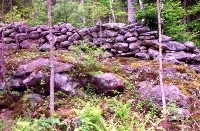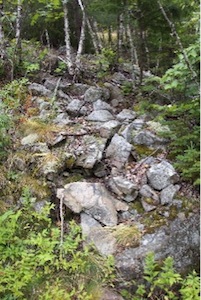
A classification that is easy-to-use, loosely defined, and often task-specific is called a typology. Essentially, this kind of classification relies on intuitive categories that may have little to do with appearance. Its subjectivity distinguishes it from a taxonomy, which is based on explicit, usually visible and measurable criteria from the object itself. The criteria are objective, for example height, width, or the presence or absence of some salient or diagnostic feature. For a more rigorous stone wall classification, refer the Taxonomy in this website, or to “Chapter 9 – Classification” of Exploring Stone Walls.
This simple typology distinguishes three kinds of walls:
ABANDONED
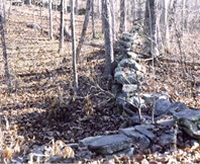
Abandoned walls, also known more affectionately as “wild walls,” are usually fairly old. They were at one time farmstead walls walls that have since become tumbled and unkempt. A very few of these (especially the oddest-shaped constructions) may be pre-European in age, but the burden of proof for this assertion lies on the person making this claim. Regardless of their original origin, abandoned walls have, by definition, become ruins.
With abandoned walls, if a stone falls down, it’s usually left where it fell. Such walls are not taken care of. This makes them no more, and no less, wild than the creatures that live on, below, within, and near them. And the fact that they are tumbled doesn’t diminish their importance, because they have become part of local ecologic and watershed processes. For clues to this wall type, look for walls that are:
- Surrounded by trees
- Tumbled and damaged, especially along the top.
- Occupy large land tracts.
- Covered by lichens and moss.
- Seldom made of quarried stone
HERITAGE
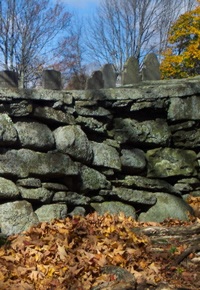
More commony called “historic walls,” these are important to local culture and history. If a stone falls down, it’s usually someone’s job to put it back in place. Perhaps they surround an old church yard. Perhaps their local stories are well known. Perhaps they are monuments unto themselves. For clues, look for walls that are:
- Often moderately well built.
- Often contain quarried stone, or large capstones not composed of quarried rock.
- Are the foundations of former buildings, known to have existed in the past.
- Surround known estates or land tracts.
- There would be public opposition if the wall were scheduled for demolition.
- Grace old roads, especially Yankee-era turnpikes.
- Mentioned in original historic documents (such as the town pound).
RECENT AND REBUILT
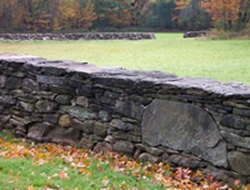
This broad category contains two basic subtypes. Most common are those walls where an old, tumbled-down wall on a formerly derelict property have been rebuilt, usually in the same place, usually by the landowner or a mason hired to do the job under their supervision. Almost as common are generally shorter sections of “new” wall built on properties with stone imported to the building site.
Though these subtypes are often distinct, in just as many cases, they are not, because the stone from an old wall can easily be moved to another place for new construction. The basic idea here is that these walls, however beautiful they might be, are not “historic.” More than half probably postdate 1970. For clues, look for walls that are:
- Ornaments to 20th and 21st century construction.
- Carefully laid
- Built of exotic (came from far away), rather than native, stone.
- Unusually well put together
- Can be documented as recent in age.
- Are in the process of being built or rebuilt.
- Are known to have been built by a living mason.
